History

The architectual monument „Small Guild” is located in the very heart of Old Riga. The building is designed by eminent Riga city`s architect Johanness Daniel Felsko under whose guidance the construction was started on 22th May 1864 by setting in the foundation stone where the newspapers of those days, a calendar, an adress-book, signatures from all seniors of the Guild and from all seniors of crafts-corporations, a short chronicle of St. John’s Guild and various other documents were contained.
Just beside the Small Guild, the shelter house of Small Guild members was built already in 1855 by the project of the same architect. The house was rebuilt in 1901 adjusting the rooms for the needs of craftsman school. Both houses have been connected and make whole complex in the strict sense as well as metaphorically for more than 100 years.
On 9th February 1866 the new Small Guild building was solemnly consecrated. The further reconstruction and interior decoration was resumed in 1888. The main reconstruction initiator of the Small Guild was the senior, Fridrich Brunstermann. The Small Guild house was built as a location place of rooms for crafts-corporations, ceremonies and representations where the disposition of rooms has developed gradually, supplementing it in the course of time with donations and gifts of separate crafts corporations.
In 1999-2000, the renovation and restoration of the Small Guild was conducted. Nearly all of the decoration of Small Guild is done in accordance with the documents and photographies of the last quarter of the 19th century.
Nowadays the building of the Small Guild is rather precisely characterised by the final quotation of the 1936 issue – “ This building offers us a unique picture of the art of old Riga crafts corporation, a true example of citizenship and unselfishness. Also the present refined looks of these luxurious interior rooms of the building are of high arts and historical value as a document of our oldest and recent arts culture…”
”
 Pašā Vecrīgas centrā pie Līvu laukuma atrodas arhitektūras piemineklis „Mazā ģilde”. Ēka celta pēc izcilā arhitekta Johana Daniela Felsko projekta. Ēkas pamatakmenī, ko ielika 1864. gada 22. maijā, ievietoti tā laika laikraksti, kalendārs, visu amatu vecāko un ģildes vecāko sola locekļu paraksti, kā arī īsa Mazās jeb Sv. Jāņa ģildes hronika. Blakus ģildes namam Amatu ielā jau 1855. gadā pēc tā paša arhitekta projekta uzcelts Mazās ģildes brāļu patversmes nams, kuru 1901. gadā pārbūvēja, piemērojot tā telpas tur iekārtojamās amatnieku skolas vajadzībām. Nu jau vairāk kā simts gadu abi šie nami- Mazās ģildes nams un patversmes nams- ir gan tiešā, gan pārnestā nozīmē organiski savienoti un veido veselu kompleksu, kurā noris Mazās ģildes dzīve. Namu svinīgi atklāja 1866. gada 9. februārī. Sevišķi bagātīgi Mazās ģildes iekšējo interjeru papildināja un izgreznoja 1888. gadā, ilggadējā ģildes vecākā Fridriha Brunstermana laikā, kad fasādes dzegā pret Meistara ielu ievietoja Mazās ģildes ģerboni, priekšnamā, vestibilā un kāpņu telpas grīdas ieklāja terraco mozaīkā. Darbus veica Frankfurtes pie Mainas firmas Johann Odorico atsūtītie itāļu meistari. Visos nama logos ievietoja mākslinieciskas krāsainas vitrāžas, kuras izgatavoja mākslinieka A. A. Freištatla darbnīcā Hanoverā. Vitrāžās amatu vecākie parādīti agrāku gadsimtu tradicionālajos tērpos, bet to portreti ir fotogrāfiski precīzi. Vecajo sola zālē ievietoti ar būvdarbiem saistīto 10 amatu vecāko portreti- darba tērpos, bet lielās zāles logos pārējo 25 amatu vecākie svētku tērpos. Vecajo sola zālē virslogu apaļajos vitrāžmedaljonos ievietoti 10 ģildes labdaru portreti ar attiecīgiem uzrakstiem, bet lielajā zālē vēl 12 labdaru portretmedaljoni. Nama durvju un logu aiļu smaiļkoku apmales grezno uzgleznoti pamācoši aforismi un izteicieni gotiskā šriftā. 1999.-2000. gadā veikta Mazās Ģildes renovācija un restaurācija. Praktiski visa Mazās ģildes apdare ir restaurēta atbilstoši 19. gs. pēdējā ceturkšņa dokumentiem un fotogrāfijām. Mazās ģildes ēku precīzi raksturo citāts no 1936. gadā izdotās brošūras: „Šis nams sniedz mums vienreizēju vecās Rīgas vāciskās, amatnieciskās iekārtas, īstas pilsonības apziņas un nesavtīgas devības ainu. Arī šī greznā nama iekštelpu izsmalcinātajam pašreizējam izskatam ir augsta mākslas vēstures vērtība kā mūsu pilsētas senākās un jaunākās mākslas kultūras dokumentam….”
Pašā Vecrīgas centrā pie Līvu laukuma atrodas arhitektūras piemineklis „Mazā ģilde”. Ēka celta pēc izcilā arhitekta Johana Daniela Felsko projekta. Ēkas pamatakmenī, ko ielika 1864. gada 22. maijā, ievietoti tā laika laikraksti, kalendārs, visu amatu vecāko un ģildes vecāko sola locekļu paraksti, kā arī īsa Mazās jeb Sv. Jāņa ģildes hronika. Blakus ģildes namam Amatu ielā jau 1855. gadā pēc tā paša arhitekta projekta uzcelts Mazās ģildes brāļu patversmes nams, kuru 1901. gadā pārbūvēja, piemērojot tā telpas tur iekārtojamās amatnieku skolas vajadzībām. Nu jau vairāk kā simts gadu abi šie nami- Mazās ģildes nams un patversmes nams- ir gan tiešā, gan pārnestā nozīmē organiski savienoti un veido veselu kompleksu, kurā noris Mazās ģildes dzīve. Namu svinīgi atklāja 1866. gada 9. februārī. Sevišķi bagātīgi Mazās ģildes iekšējo interjeru papildināja un izgreznoja 1888. gadā, ilggadējā ģildes vecākā Fridriha Brunstermana laikā, kad fasādes dzegā pret Meistara ielu ievietoja Mazās ģildes ģerboni, priekšnamā, vestibilā un kāpņu telpas grīdas ieklāja terraco mozaīkā. Darbus veica Frankfurtes pie Mainas firmas Johann Odorico atsūtītie itāļu meistari. Visos nama logos ievietoja mākslinieciskas krāsainas vitrāžas, kuras izgatavoja mākslinieka A. A. Freištatla darbnīcā Hanoverā. Vitrāžās amatu vecākie parādīti agrāku gadsimtu tradicionālajos tērpos, bet to portreti ir fotogrāfiski precīzi. Vecajo sola zālē ievietoti ar būvdarbiem saistīto 10 amatu vecāko portreti- darba tērpos, bet lielās zāles logos pārējo 25 amatu vecākie svētku tērpos. Vecajo sola zālē virslogu apaļajos vitrāžmedaljonos ievietoti 10 ģildes labdaru portreti ar attiecīgiem uzrakstiem, bet lielajā zālē vēl 12 labdaru portretmedaljoni. Nama durvju un logu aiļu smaiļkoku apmales grezno uzgleznoti pamācoši aforismi un izteicieni gotiskā šriftā. 1999.-2000. gadā veikta Mazās Ģildes renovācija un restaurācija. Praktiski visa Mazās ģildes apdare ir restaurēta atbilstoši 19. gs. pēdējā ceturkšņa dokumentiem un fotogrāfijām. Mazās ģildes ēku precīzi raksturo citāts no 1936. gadā izdotās brošūras: „Šis nams sniedz mums vienreizēju vecās Rīgas vāciskās, amatnieciskās iekārtas, īstas pilsonības apziņas un nesavtīgas devības ainu. Arī šī greznā nama iekštelpu izsmalcinātajam pašreizējam izskatam ir augsta mākslas vēstures vērtība kā mūsu pilsētas senākās un jaunākās mākslas kultūras dokumentam….”

